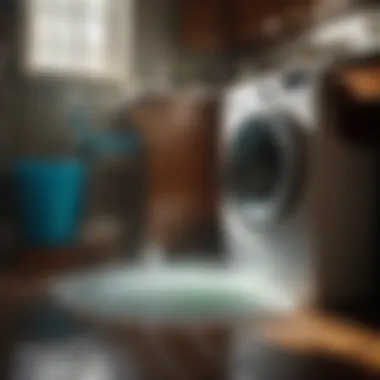Expert Guide: How to Eliminate Sewer Smell in Your Laundry Room


Materials:
- Baking soda: 1 cup
- Vinegar: 1 cup
- Hot water: 2 cups
- Rubber gloves: 1 pair
- Protective mask: 1
- Bucket: 1
DIY Steps:
- Identifying the Source: Begin by locating where the sewer smell is strongest in the laundry room. Check sink drains, floor drains, and washing machine connections.
- Testing Drains: Pour a mixture of hot water and vinegar down the drains to see if it alleviates the odor. If it does not, move to more in-depth solutions.
- Cleaning the Washing Machine: Run a hot water cycle with baking soda to clean the washing machine and remove any built-up residue causing the smell.
- Inspecting Vent Pipes: Check for any blockages in the vent pipes connected to the sewer system. Clear any debris or obstructions to allow proper airflow.
Technical Aspects:
- Tools: Screwdriver, plunger, drain snake
- Timing specifics: Approximately 1-2 hours for completion
- Critical techniques: Proper ventilation, use of protective gear when handling chemicals
DIY Project Process:
- Clean Drain Lines: Use a drain snake to clear any clogs in the drain lines leading from the laundry room to the sewer system.
- Sealing Leaks: Inspect for any leaks in the plumbing system and seal them with appropriate sealants to prevent sewer gas from entering the room.
- Checking P-Trap: Ensure the P-trap under the sink is filled with water to prevent sewer gas from escaping. Add water as needed.
Troubleshooting Tips:
- If the odor persists, consider consulting a professional plumber to conduct a more thorough inspection of your plumbing system.
- Make sure to repeat the odor treatment process regularly to prevent the smell from returning.
Introduction
In the realm of household maintenance, the issue of sewer smell emanating from the laundry room is a prevalent concern that can significantly impact the overall living environment. Addressing this problem is crucial not only for maintaining a pleasant home atmosphere but also for ensuring the well-being of the occupants. This comprehensive guide delves into the intricacies of combatting sewer odors within the laundry room setting, offering essential insights and practical solutions for homeowners to effectively manage and eradicate this unpleasant issue.
Background Information
Understanding the Concern
Understanding the concern of sewer smell in the laundry room is paramount to comprehending its underlying causes and subsequent remedial actions. This awareness forms the cornerstone of tackling the problem successfully. By recognizing the origins of the odor, homeowners can implement targeted strategies to eliminate it at its root. Understanding the concern provides a detailed analysis of how sewer smells develop, allowing for effective mitigation measures.
Impact on Home Environment
The impact of sewer smell in the home environment extends beyond mere olfactory discomfort. Not only does it create an unpleasant living space, but it can also indicate more significant plumbing or ventilation issues that require immediate attention. Detecting the odor's impact on the home environment serves as an alert to potential health hazards and structural concerns, emphasizing the urgency of addressing the issue promptly. By understanding the implications of sewer smell, homeowners can safeguard their living conditions and enhance their quality of life.
Scope of the Article
Outlining the Focus


Outlining the focus of this article involves delineating the specific aspects related to sewer smell in the laundry room that will be explored in-depth. By outlining these key areas, readers gain a clear understanding of the scope of information provided, enabling them to navigate the content seamlessly. This structuring ensures that essential topics are highlighted and comprehensively discussed, facilitating a systematic approach to resolving sewer odor concerns.
Key Objectives
The key objectives of this article aim to guide homeowners through a step-by-step process of addressing and remedying sewer smell in their laundry rooms. By elucidating these objectives, readers can grasp the overarching goals of implementing the suggested solutions effectively. The outlined objectives serve as a roadmap for homeowners to follow, enabling them to navigate through the article with clarity and purpose, ultimately achieving a fresh and odor-free laundry room environment.
Causes of Sewer Smell
In the comprehensive guide on addressing sewer smell from the laundry room, understanding the causes of the unpleasant odor is paramount. By delving into the specifics of what leads to this issue, homeowners can effectively identify and rectify the source, ensuring a fresh and clean environment. Exploring the nuances of each potential cause sets the foundation for implementing targeted solutions and preventing future recurrences, aligning with the article's objective of offering a complete resolution to the sewer smell problem.
Plumbing Issues
Drain Blockages
Unraveling the complexities within the plumbing system is crucial in dissecting the causes of sewer smell. Drain blockages emerge as a significant contributor to the emanating odors, often resulting from accumulation and obstruction in the piping. Understanding the mechanisms behind drain blockages enables homeowners to proactively address this common issue, highlighting its prevalence in residences and emphasizing the pivotal role it plays in perpetuating sewer smell problems. By elucidating the repercussions of untreated drain blockages on the overall system, the article sheds light on why tackling this specific aspect is essential for a successful resolution.
Damaged Sewer Pipes
Damaged sewer pipes present another prevalent issue that amplifies sewer smell concerns in the laundry room. The compromised integrity of sewer pipes introduces the risk of leaks and seepage, exacerbating the foul odors permeating the space. By illustrating the specific repercussions of damaged sewer pipes on the overall plumbing system, homeowners can grasp the urgency of addressing this critical component in mitigating sewer smell. Exploring the characteristics of damaged sewer pipes and their distinctive impact emphasizes the need for prompt intervention to restore the system's functionality and eliminate the root cause of the odor.
Ventilation Problems
Inadequate Ventilation
Ventilation problems introduce a layer of complexity to the sewer smell issue, underscoring the importance of proper airflow in maintaining a fresh and odor-free environment. Inadequate ventilation hinders the expulsion of noxious gases, creating a conducive environment for unpleasant smells to linger and intensify. By articulating the significance of adequate ventilation in averting sewer smell problems, the article educates homeowners on the critical role this element plays in preserving indoor air quality. Exploring the unique challenges posed by inadequate ventilation underscores its impact on exacerbating sewer smell concerns, guiding readers towards strategic solutions to enhance ventilation efficiency and alleviate the persistent odors.
Vent Pipe Clogs
Vent pipe clogs further compound the ventilation challenges faced in addressing sewer smell, impeding the natural flow of air and aggravating the issue at hand. These obstructions disrupt the ventilation system's functionality, contributing to a stagnant environment that fosters the retention of unpleasant odors. By outlining the intricacies of vent pipe clogs and their consequential effects on indoor air quality, the article empowers homeowners with the knowledge needed to identify and resolve this specific hindrance. Delving into the advantages and disadvantages of dealing with vent pipe clogs equips readers with critical insights to facilitate informed decision-making and initiate targeted solutions for enhanced ventilation performance.
Dry P-Trap
Explanation
The dry P-trap stands out as a noteworthy factor in the prevalence of sewer smell within laundry rooms, indicating a lapse in maintenance and water replenishment. This component, integral to preventing odors from seeping back into living spaces, warrants a detailed explanation to underscore its significance in the context of addressing sewer smell. By illustrating the mechanism by which a dry P-trap leads to foul odors and emphasizing the necessity of regular upkeep, the article guides homeowners towards recognizing and rectifying this common issue. Describing the advantages and disadvantages associated with maintaining a functional P-trap offers readers a comprehensive understanding of its role and reinforces the importance of proactive maintenance to combat sewer smell effectively.
Signs of a Dry P-Trap


Identifying the signs of a dry P-trap serves as a pivotal step in diagnosing sewer smell issues, providing a clear indicator of potential maintenance lapses within the plumbing system. By highlighting the specific cues that suggest a depleted P-trap and elucidating their implications on indoor air quality, homeowners can swiftly address this underlying cause to alleviate the ongoing odor nuisance. Exploring the advantages of promptly recognizing and addressing a dry P-trap and the drawbacks of neglecting this maintenance task equips readers with essential knowledge to uphold a functional drainage system and uphold a fresh atmosphere in their laundry room.
Diagnosing the Issue
In this article, the section on Diagnosing the Issue plays a crucial role in helping homeowners tackle the sewer smell problem emanating from their laundry rooms effectively. By understanding the importance of diagnosing the issue, individuals can pinpoint the root cause of the odor and implement targeted solutions, leading to a fresher and more pleasant home environment.
Initial Assessment
Odor Identification
Odor Identification is a key aspect of the initial assessment process when addressing sewer smells in the laundry room. By discerning the specific odor profile, homeowners can narrow down potential causes, whether it's a musty, sulfurous, or other distinct smell emanating from the drain. This careful identification is vital as it serves as the first step towards effective remediation strategies. The ability to accurately identify the type of odor ensures that subsequent actions are tailored to combat the specific issue, providing a more efficient and lasting solution.
Observational Analysis
Observational Analysis complements Odor Identification by adding a visual and situational perspective to the diagnostic process. Through observing factors like water flow, drainage patterns, and potential leaks, homeowners can gather valuable clues about the underlying problem causing the sewer smell. This methodical observation enables individuals to detect subtler signs that may not be apparent through odor alone. By combining Odor Identification with Observational Analysis, homeowners can assemble a more comprehensive understanding of the issue at hand, facilitating targeted and effective intervention.
Professional Inspection
Seeking Expert Help
Seeking Expert Help is a critical component of diagnosing persistent sewer smells in the laundry room. Professionals possess the expertise and tools necessary to conduct thorough investigations beyond the scope of initial assessments. Their trained eye can identify intricate issues such as hidden leaks, pipe corrosion, or ventilation malfunctions that may elude untrained individuals. Collaborating with experts ensures a meticulous examination of the plumbing system, guiding homeowners towards accurate diagnoses and tailored solutions specific to their home.
Diagnostic Procedures
Diagnostic Procedures employed by professionals involve advanced techniques and tools to delve deeper into the root cause of sewer smells. Through pressure testing, camera inspections, and smoke tests, experts can uncover hidden defects within the plumbing system that contribute to the unpleasant odors. These procedures offer conclusive evidence and detailed insights, aiding in the development of precise and effective remediation strategies. By entrusting diagnostic procedures to skilled professionals, homeowners can expedite the resolution process and regain a fresh and odor-free laundry room environment.
Effective Solutions
In the realm of addressing sewer smell issues in the laundry room, effective solutions play a pivotal role in abolishing the unpleasant odors and restoring a fresh atmosphere to the home. These solutions form the core essence of this article, offering a detailed roadmap for homeowners to combat and resolve the pervasive sewer smell problem efficiently and effectively. By delving into the specific elements and benefits of these solutions, individuals can strategically tackle the issue at its root, ensuring long-term relief from the noxious odors that can permeate the laundry space.
DIY Remedies
Cleaning Drainage System:
Cleaning the drainage system is a vital aspect of resolving sewer smell concerns in the laundry room. This proactive measure involves eliminating built-up debris, grime, and blockages within the plumbing system, ensuring smooth water flow and preventing foul odors from emanating into the living spaces. The key characteristic of this DIY remedy lies in its simplicity and cost-effectiveness, making it a popular choice among homeowners looking to address sewer smell issues promptly. By regularly cleaning the drainage system, individuals can maintain optimal hygiene levels and prevent recurring odor problems efficiently.
Replenishing P-Trap Water:


Replenishing the water in the P-trap is a fundamental step in mitigating sewer smell concerns in the laundry room. The P-trap, a U-shaped pipe under the sink or drain, acts as a barrier to sewer gases, preventing them from entering the living areas. Over time, the water in the P-trap can evaporate, leading to the escape of odors. By replenishing this water regularly, homeowners can ensure that the P-trap functions effectively, serving its purpose of odor control efficiently. This unique feature of replenishing P-trap water is essential in maintaining a fresh and hygienic environment in the laundry room.
Professional Interventions
Plumber Services:
Engaging professional plumber services is a significant aspect of effectively addressing sewer smell issues in the laundry room. Experienced plumbers possess the expertise and tools required to diagnose and rectify complex plumbing issues that may be causing the persistent odor problem. The key characteristic of plumber services lies in their precision and efficiency, ensuring that the underlying causes of sewer smells are identified and resolved comprehensively. By opting for professional interventions, homeowners can access tailored solutions that target specific plumbing issues, guaranteeing long-lasting relief from foul odors.
Ventilation System Upgrades:
Upgrading the ventilation system is a strategic measure in combatting sewer smell problems in the laundry room. Adequate ventilation is crucial for expelling stale air and preventing the accumulation of unpleasant odors in enclosed spaces. Ventilation system upgrades enhance airflow, circulation, and odor control, creating a healthier and more refreshing environment within the laundry room. The unique feature of ventilation system upgrades lies in their ability to optimize indoor air quality, fostering a clean and revitalizing atmosphere for homeowners.
Preventive Measures
Regular Maintenance:
Routine maintenance is a cornerstone of preventing sewer smell issues in the laundry room. Consistent upkeep of plumbing systems, drainage components, and ventilation systems can mitigate the risk of odor problems emerging. The key characteristic of regular maintenance is its proactive nature, preemptively addressing potential issues before they escalate into significant odor concerns. By adhering to a regimen of regular maintenance, homeowners can uphold the cleanliness and functionality of their home systems, ensuring a odor-free environment in the laundry space.
Homeowner Tips:
Implementing homeowner tips is a practical approach to maintaining a fresh and pleasant atmosphere in the laundry room. These tips encompass simple yet effective practices like using mild cleaning agents, avoiding the disposal of grease or harsh chemicals down drains, and ventilating the area adequately during and after laundry activities. The unique feature of homeowner tips lies in their accessibility and usability, empowering individuals to adopt habits that promote good sanitation and odor prevention in their homes. By incorporating these tips into their daily routines, homeowners can proactively combat sewer smell issues and sustain a clean living environment.
Conclusion
In this article on addressing sewer smell from the laundry room, the significance of effectively resolving this issue cannot be overstated. The conclusion serves as a vital component, bringing together the insights provided in the preceding sections to empower homeowners in combatting unpleasant odors effectively. By implementing the recommended solutions and preventive measures, individuals can transform their home environments into spaces free from sewer smells and associated concerns. The concluding segment consolidates the information shared, reinforcing the essential steps needed to address and eliminate the root causes of sewer odors in the laundry room for a more comfortable and hygienic living space.
Summary of Key Points
Recap of Causes
An in-depth exploration of the causes contributing to sewer smells in the laundry room sheds light on the plumbing and ventilation issues that can lead to this undesirable odor. By dissecting each causative factor, homeowners can identify the specific source of the problem within their own laundry room setups. Understanding the root causes is paramount to implementing targeted solutions that address the issue at its core, ensuring a thorough and effective elimination of sewer odors.
Effective Solutions Highlight
Highlighting the effective solutions underscores the actionable strategies available to homeowners looking to tackle sewer smells effectively. From DIY remedies for immediate relief to professional interventions that offer long-term solutions, the range of options presented caters to varying levels of complexity and expertise. By delving into the benefits and considerations of each solution highlighted, individuals gain comprehensive guidance on selecting the most suitable approach based on their unique circumstances.
Final Thoughts
Encouragement for Action
Encouraging proactive engagement with the issue of sewer smells in the laundry room emphasizes the empowerment that comes with taking initiative to address household challenges. By motivating readers to embark on a journey towards a fresher and more pleasant home environment, the call for action inspires confidence in the efficacy of the solutions provided within this comprehensive guide.
Importance of Resolving Issue
Underscoring the importance of promptly resolving the issue of sewer smells reinforces the significance of maintaining a healthy and odor-free living space. Beyond the immediate discomfort caused by these odors, unresolved problems can escalate and lead to more extensive and costly repairs. By recognizing the value of early intervention and preventive maintenance, homeowners can safeguard their homes against recurring sewer smell issues, ensuring long-term comfort and well-being.







